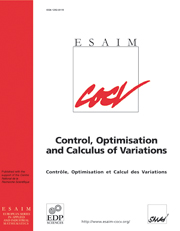Article contents
A simple proof of the characterization of functions of low Aviles Giga energy on a ball via regularity
Published online by Cambridge University Press: 13 April 2011
Abstract
The Aviles Giga functional is a well known second order functional that forms a model for
blistering and in a certain regime liquid crystals, a related functional models thin
magnetized films. Given Lipschitz domain Ω ⊂ ℝ2 the functional
is
\hbox{$I_{\ep}(u)=\frac{1}{2}\int_{\Omega}
\ep^{-1}\lt|1-\lt|Du\rt|^2\rt|^2+\ep\lt|D^2 u\rt|^2 {\rm d}z$} Iϵ(u)=12∫Ωϵ-11−Du22+ϵD2u2dz where
u belongs to the subset of functions in
\hbox{$W^{2,2}_{0}(\Omega)$}
Iϵ(u)=12∫Ωϵ-11−Du22+ϵD2u2dz where
u belongs to the subset of functions in
\hbox{$W^{2,2}_{0}(\Omega)$} W02,2(Ω) whose gradient (in the
sense of trace) satisfies
Du(x)·ηx = 1
where ηx is the inward pointing unit normal
to ∂Ω at x. In [Ann. Sc. Norm. Super. Pisa Cl.
Sci. 1 (2002) 187–202] Jabin et al. characterized
a class of functions which includes all limits of sequences
\hbox{$u_n\in W^{2,2}_0(\Omega)$}
W02,2(Ω) whose gradient (in the
sense of trace) satisfies
Du(x)·ηx = 1
where ηx is the inward pointing unit normal
to ∂Ω at x. In [Ann. Sc. Norm. Super. Pisa Cl.
Sci. 1 (2002) 187–202] Jabin et al. characterized
a class of functions which includes all limits of sequences
\hbox{$u_n\in W^{2,2}_0(\Omega)$} un∈W02,2(Ω) with
Iϵn(un) → 0
as ϵn → 0. A corollary to their work is that
if there exists such a sequence (un) for a
bounded domain Ω, then Ω must be a ball and (up to
change of sign)
u: = limn → ∞un = dist(·,∂Ω).
Recently [Lorent, Ann. Sc. Norm. Super. Pisa Cl. Sci. (submitted),
http://arxiv.org/abs/0902.0154v1] we provided a quantitative generalization
of this corollary over the space of convex domains using ‘compensated compactness’
inspired calculations of DeSimone et al. [Proc. Soc. Edinb. Sect.
A 131 (2001) 833–844]. In this note we use methods of regularity
theory and ODE to provide a sharper estimate and a much simpler proof for the case where
Ω = B1(0) without the requiring the trace
condition on Du.
un∈W02,2(Ω) with
Iϵn(un) → 0
as ϵn → 0. A corollary to their work is that
if there exists such a sequence (un) for a
bounded domain Ω, then Ω must be a ball and (up to
change of sign)
u: = limn → ∞un = dist(·,∂Ω).
Recently [Lorent, Ann. Sc. Norm. Super. Pisa Cl. Sci. (submitted),
http://arxiv.org/abs/0902.0154v1] we provided a quantitative generalization
of this corollary over the space of convex domains using ‘compensated compactness’
inspired calculations of DeSimone et al. [Proc. Soc. Edinb. Sect.
A 131 (2001) 833–844]. In this note we use methods of regularity
theory and ODE to provide a sharper estimate and a much simpler proof for the case where
Ω = B1(0) without the requiring the trace
condition on Du.
Keywords
- Type
- Research Article
- Information
- ESAIM: Control, Optimisation and Calculus of Variations , Volume 18 , Issue 2 , April 2012 , pp. 383 - 400
- Copyright
- © EDP Sciences, SMAI, 2011
References
- 4
- Cited by




